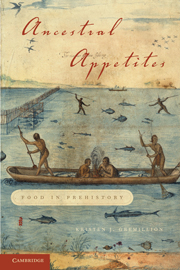3 - Foraging
Published online by Cambridge University Press: 05 June 2012
Summary
Man falls upon everything that comes in his way; not the smallest fruit or excrescence of the earth, scarce a berry or a mushroom can escape him.
Joseph Addison, in The SpectatorThe pace of change in human foodways picked up considerably after 100,000 years ago. Whereas some of these innovations in food technology had predecessors in earlier millennia, many did not; those that did have a history were elaborated, diversified, and improved. Many, if not all, of these new ways of acquiring and processing food originated with fully modern people who had essentially the same anatomy, physiology, and cognitive capabilities as we do. The apparent novelty of some behaviors is no doubt an illusion created by the increasing visibility and preservation of material remnants of human activities, but that is not the whole story. Instead, the record as we know it reflects a real and significant shift in the way humans related to the natural world and to each other.
THE UPPER PALEOLITHIC REVOLUTION?
Since the nineteenth century, archaeologists working in Europe were keenly aware of the contrasts between the habitations and tool traditions of modern people (then known as “Cro-Magnons”) and the Neanderthals, archaic humans whose behavioral repertoire seemed quite limited in comparison. The Cro-Magnons seemed more like modern humans. Their toolkits were extensive and specialized; they hunted migratory game, fished, sewed, and built shelters.
- Type
- Chapter
- Information
- Ancestral AppetitesFood in Prehistory, pp. 31 - 47Publisher: Cambridge University PressPrint publication year: 2011

